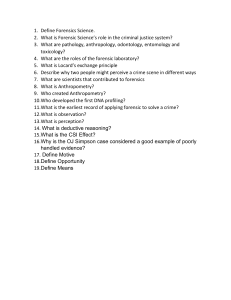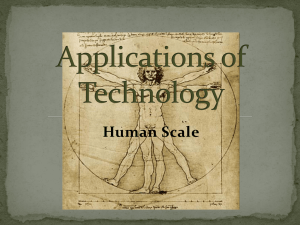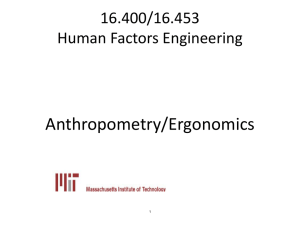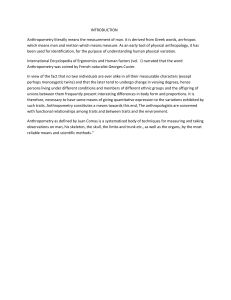Uploaded by
mail
3D Body Scanning for Human Anthropometry
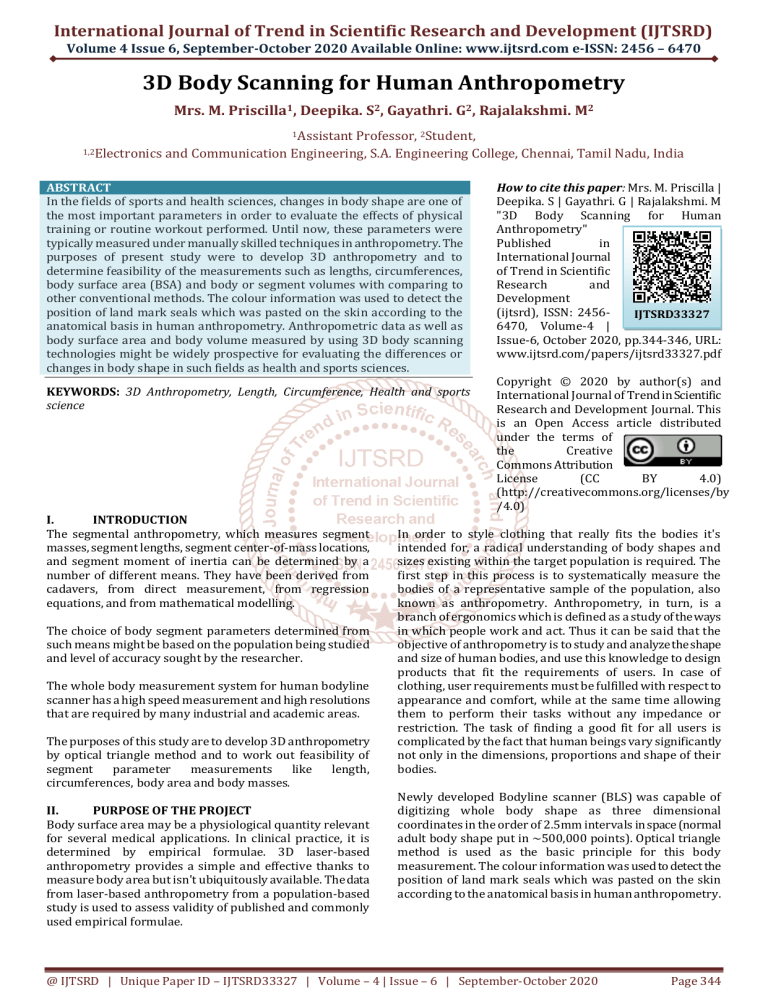
International Journal of Trend in Scientific Research and Development (IJTSRD) Volume 4 Issue 6, September-October 2020 Available Online: www.ijtsrd.com e-ISSN: 2456 – 6470 3D Body Scanning for Human Anthropometry Mrs. M. Priscilla1, Deepika. S2, Gayathri. G2, Rajalakshmi. M2 1Assistant 1,2Electronics Professor, 2Student, and Communication Engineering, S.A. Engineering College, Chennai, Tamil Nadu, India ABSTRACT In the fields of sports and health sciences, changes in body shape are one of the most important parameters in order to evaluate the effects of physical training or routine workout performed. Until now, these parameters were typically measured under manually skilled techniques in anthropometry. The purposes of present study were to develop 3D anthropometry and to determine feasibility of the measurements such as lengths, circumferences, body surface area (BSA) and body or segment volumes with comparing to other conventional methods. The colour information was used to detect the position of land mark seals which was pasted on the skin according to the anatomical basis in human anthropometry. Anthropometric data as well as body surface area and body volume measured by using 3D body scanning technologies might be widely prospective for evaluating the differences or changes in body shape in such fields as health and sports sciences. KEYWORDS: 3D Anthropometry, Length, Circumference, Health and sports science I. INTRODUCTION The segmental anthropometry, which measures segment masses, segment lengths, segment center-of-mass locations, and segment moment of inertia can be determined by a number of different means. They have been derived from cadavers, from direct measurement, from regression equations, and from mathematical modelling. The choice of body segment parameters determined from such means might be based on the population being studied and level of accuracy sought by the researcher. The whole body measurement system for human bodyline scanner has a high speed measurement and high resolutions that are required by many industrial and academic areas. The purposes of this study are to develop 3D anthropometry by optical triangle method and to work out feasibility of segment parameter measurements like length, circumferences, body area and body masses. II. PURPOSE OF THE PROJECT Body surface area may be a physiological quantity relevant for several medical applications. In clinical practice, it is determined by empirical formulae. 3D laser-based anthropometry provides a simple and effective thanks to measure body area but isn't ubiquitously available. The data from laser-based anthropometry from a population-based study is used to assess validity of published and commonly used empirical formulae. How to cite this paper: Mrs. M. Priscilla | Deepika. S | Gayathri. G | Rajalakshmi. M "3D Body Scanning for Human Anthropometry" Published in International Journal of Trend in Scientific Research and Development (ijtsrd), ISSN: 2456IJTSRD33327 6470, Volume-4 | Issue-6, October 2020, pp.344-346, URL: www.ijtsrd.com/papers/ijtsrd33327.pdf Copyright © 2020 by author(s) and International Journal of Trend in Scientific Research and Development Journal. This is an Open Access article distributed under the terms of the Creative Commons Attribution License (CC BY 4.0) (http://creativecommons.org/licenses/by /4.0) In order to style clothing that really fits the bodies it's intended for, a radical understanding of body shapes and sizes existing within the target population is required. The first step in this process is to systematically measure the bodies of a representative sample of the population, also known as anthropometry. Anthropometry, in turn, is a branch of ergonomics which is defined as a study of the ways in which people work and act. Thus it can be said that the objective of anthropometry is to study and analyze the shape and size of human bodies, and use this knowledge to design products that fit the requirements of users. In case of clothing, user requirements must be fulfilled with respect to appearance and comfort, while at the same time allowing them to perform their tasks without any impedance or restriction. The task of finding a good fit for all users is complicated by the fact that human beings vary significantly not only in the dimensions, proportions and shape of their bodies. Newly developed Bodyline scanner (BLS) was capable of digitizing whole body shape as three dimensional coordinates in the order of 2.5mm intervals in space (normal adult body shape put in ~500,000 points). Optical triangle method is used as the basic principle for this body measurement. The colour information was used to detect the position of land mark seals which was pasted on the skin according to the anatomical basis in human anthropometry. @ IJTSRD | Unique Paper ID – IJTSRD33327 | Volume – 4 | Issue – 6 | September-October 2020 Page 344 International Journal of Trend in Scientific Research and Development (IJTSRD) @ www.ijtsrd.com eISSN: 2456-6470 III. PRINCIPLE OF WORKING A. Block Diagram B. Algorithm Step1 : Train the sample image with the description such as gender, age. Step 2 : Capture the image. Step 3 : Store that image as input image. Step 4 : Get the outline of an image through gravity sensor and camera parameter. Step 5 : Convert the input image into grey level image. Step 6 : Segment the grey level image Step 7 : Convert the segmented image into 3D using optical triangular method. Step 8 : Measure the required parameters by comparing the 3D image with the trained image. C. Capture and Storing Image The process of obtaining a digital image from a vision sensor such as a camera is known as capturing the image. The captured image is then feed into the computer memory. Outline image: The body outline is extracted from the front and side photographs to segment the body figure from the background. In this process, the guiding outlines are used as the departing point for the process. Camera rotation is estimated from the gravity sensor of the phone and therefore the camera position is estimated from the peak provided by the person and assuming that the camera is pointing to the centre of the person. These parameters along with the body outlines are used as inputs for the 3D reconstruction process. E. Feature Extraction The relevant information of the image is extracted techniques applying on images for certain applications like, pattern matching, object detection, content based image classification, contour profiling is called the image feature extraction. The main objective is to solve the computational tasks as per the requirements of the applications. Feature extractions techniques mainly depends on the dimensionally reduction. D. Guiding Image Bundle adjustment Outline image Bundle adjustment: The variety of 3D points is depicted from different viewing point by the given set of images. Bundle adjustment is often defined, because the problem of simultaneously refining the 3D coordinates describing the scene geometry. The parameters of the relative motion and therefore the optical characteristics of the camera employed to accumulate the pictures, consistent with an optimality criterion involving the corresponding image projections of all points. @ IJTSRD | Unique Paper ID – IJTSRD33327 | Volume – 4 | Issue – 6 | September-October 2020 Page 345 International Journal of Trend in Scientific Research and Development (IJTSRD) @ www.ijtsrd.com eISSN: 2456-6470 made-to-measure wearable equipment or orthotics). (e.g. clothes, protective Moreover, our solution can contribute to spreading the digitalisation of 3D bodies to any home or point-of-sale, in particular by overcoming the barriers related to price, dedicated space, availability and usability of the body measuring hardware. The three aspects such as good precision of the measurements, realistic body shape representation and possibility of using at home, make the methods proposed potentially suitable as user data input for size advice and online fit simulations of wearable, either as body measurements or even as 3D models. VI. FUTURE WORK The resulted 3D models are dense, homologous and watertight representations of the human body which make it possible to develop interfaces to transfer the geometry of the model efficiently and accurately to mesh topologies or models compatible with the applications. Nevertheless, a further experimental study with a sample of additional population groups including children and adults from different regions of the world would be necessary to demonstrate the potential for the international application of this technology. VII. REFERENCE [1] J. A. Hodgdon, “Body composition in the military services: Standards and methods,” in Body Composition and Physical Performance: Applications for the Military Services. Washington, DC, USA: National Academies Press, 1992, pp. 57–70. [2] J. D. Lin, W. K. Chiou, H. F. Weng, J. T. Fang, and T. H. Liu, “Application of three-dimensional body scanner: Observation of prevalence of metabolic syndrome,” Clin. Nutrition, vol.23, no.6, pp. 1313–1323, 2004. IV. RESULT AND DISCUSSION Optical Cross Sectioning using Slit LASER and special CCD camera. It is based on the principle Triangulation Method. [3] N. Werghi, “Segmentation and modeling of full human body shape from 3-D scan data: A survey,” IEEE Trans. Syst., Man, Cybern. C, Appl. Rev., vol. 37, no. 6, pp. 1122–1136, Nov. 2007. It has high Resolution (1mm), accuracy (0.5%) and high Scan Speed at 5 (5mm pitch) or 10 sec (2.5 mm pitch). Combine with Bodyline Manager gives more accurate measurements. [4] S. Wuhrer, Z. B. Azouz, and C. Shu, “Posture invariant surface description and feature extraction,” in Proc. IEEE Conf. Computer Vision Pattern Recog., 2010, pp. 374–381. V. CONCLUSION The data-driven 3D reconstruction of human bodies has been proposed, implemented and demonstrated. Moreover, the precision and the accuracy of the prototype is determined. This work is feasible to provide realistic and perceptually accurate 3D reconstructions of full bodies of human equipped with image processing and 3D reconstruction software. [5] H. Han and Y. Nam, “Automatic body landmark identification for various body figures,” Int. J. Ind. Ergonomics, vol. 41, no. 6, pp. 592–606, 2011. Despite the fact that the precision is slightly lower than that of high-end body scanners, it can be acceptable for applications such as size recommendation, bespoke and [6] D. Anguelov, P. Srinivasan, D. Koller, S. Thrun, J. Rodgers, and J. Davis, “SCAPE: shape completion and animation of people,” ACM Trans. Graph., vol. 24, no. 3, pp. 408–416, Jul. 2005. [7] N. Hasler, C. Stoll, M. Sunkel, B. Rosenhahn, and H. P. Seidel, “A statistical model of human pose and body shape,” Compu.Graphics Forum, vol. 28, no. 2, 337–346, 2009. @ IJTSRD | Unique Paper ID – IJTSRD33327 | Volume – 4 | Issue – 6 | September-October 2020 Page 346
